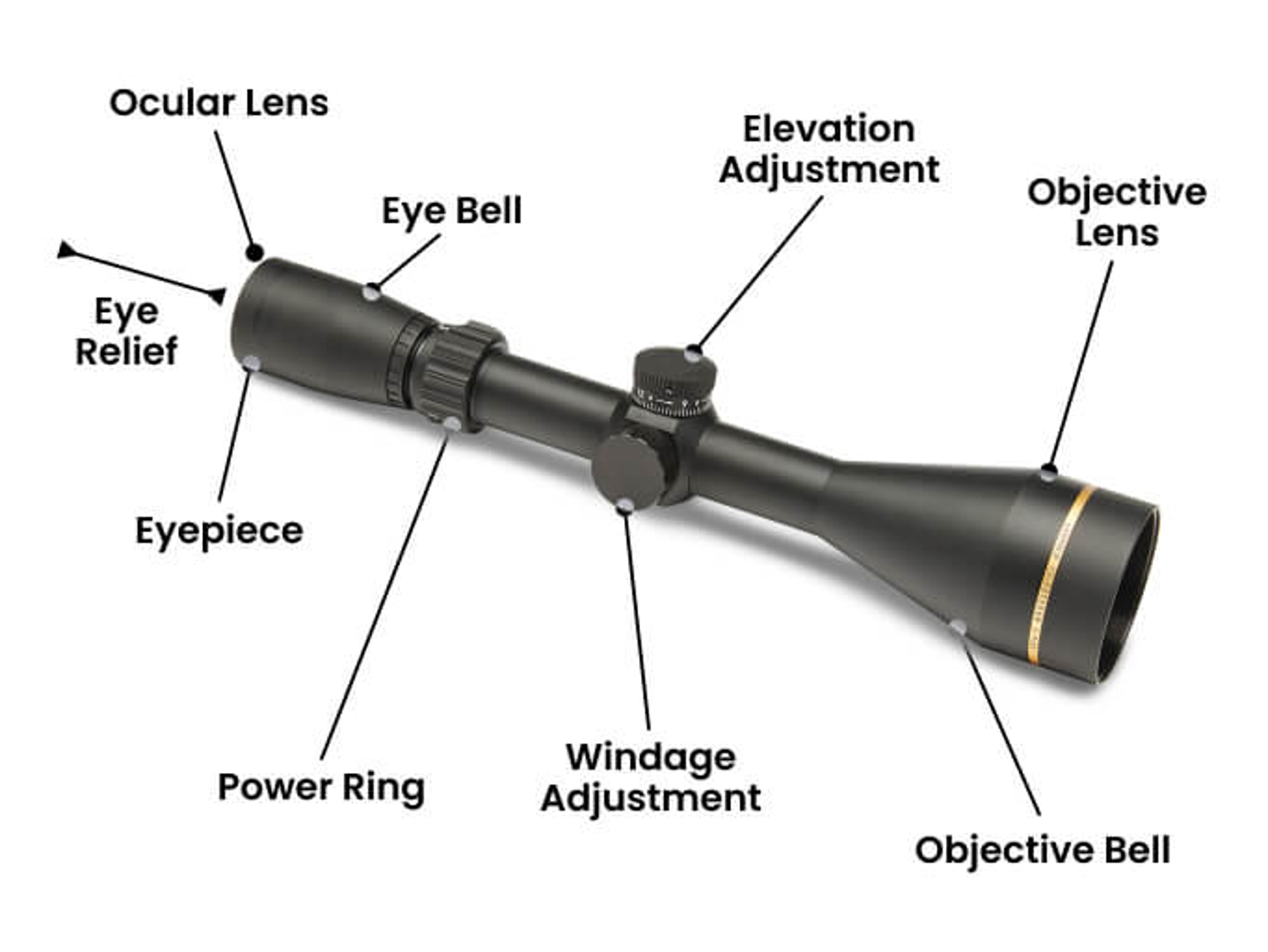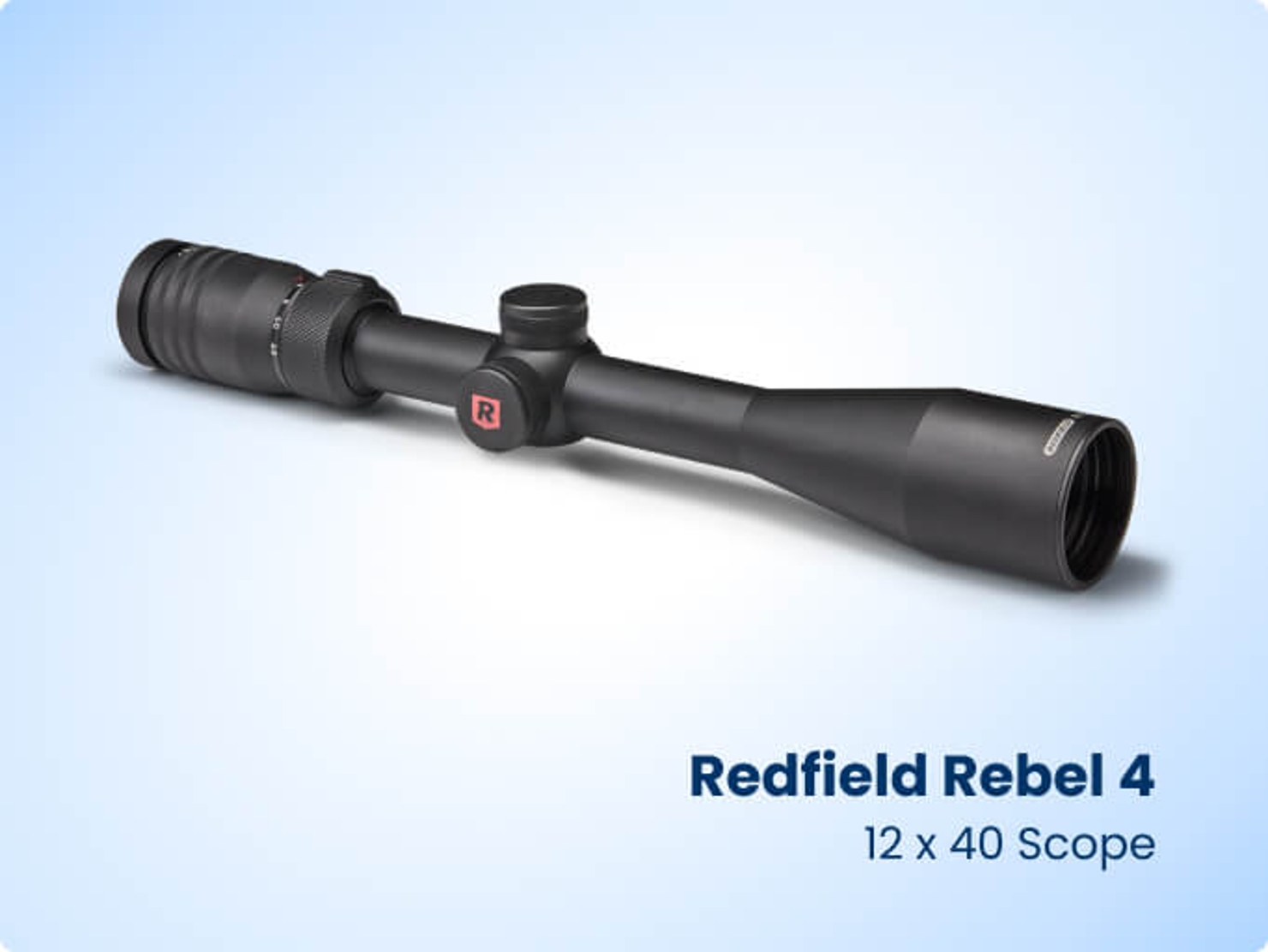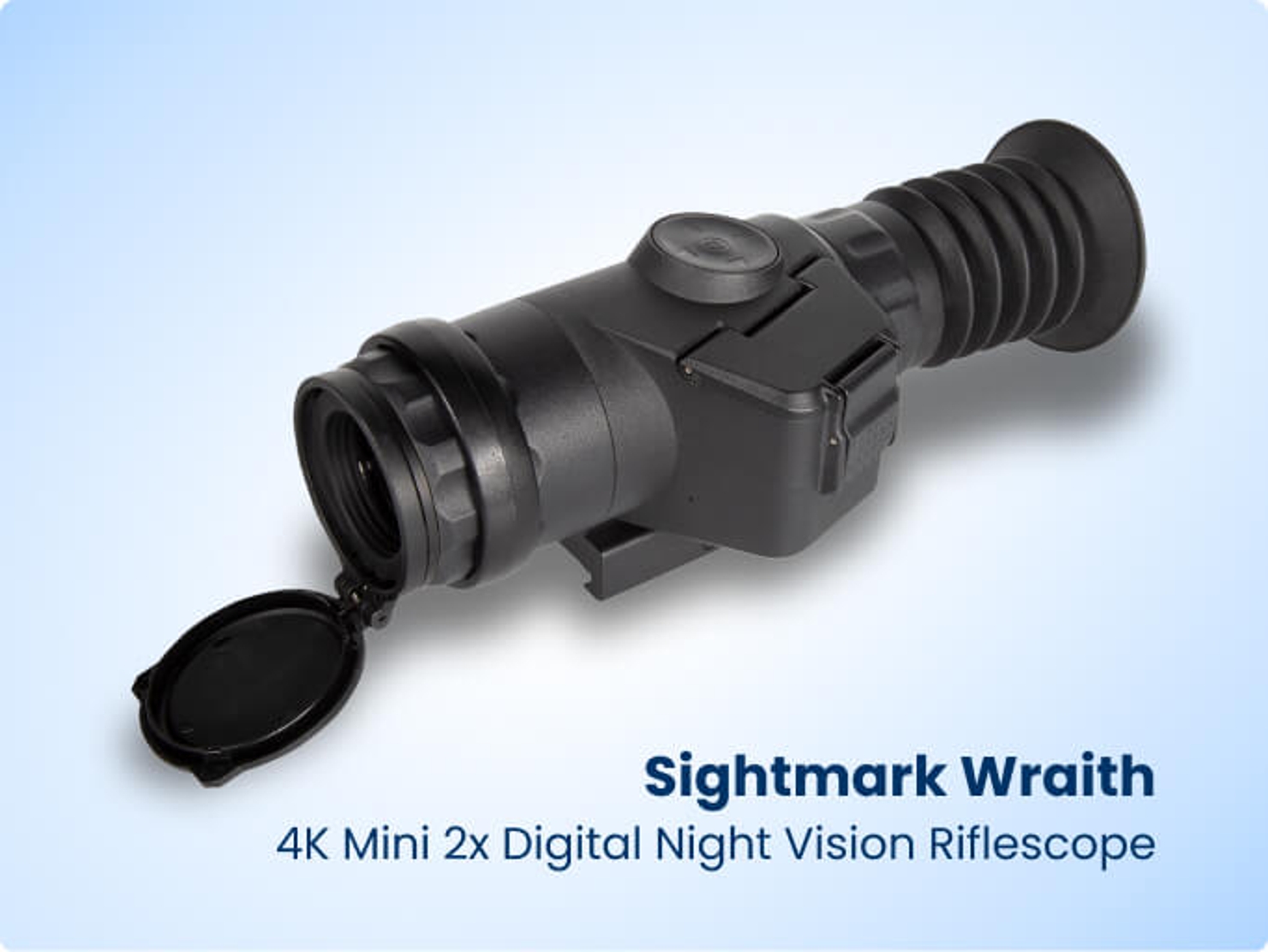Rifle Scopes Explained: How To Choose the Best Type

Want to improve your skills when hunting or target shooting? The proper type of rifle scope can upgrade more than your accuracy! We recently caught up with Jeff Danker about his favorite rifle scope tips for beginners. Jeff hosts BuckVentures Outdoors, a hunting show that centers around his long history and passion for chasing whitetails! Keep reading to learn how to choose the best scope for you and your own unique needs.
What is a Rifle Scope?
A rifle scope (also known as a telescopic sight) is a device that improves your sight and accuracy when shooting or hunting. It features magnifying lenses and an aiming instrument called a reticle that gives you an indication of where your shot will go. Scopes have several handy use cases with firearms like rifles and pistols.
How To Choose a Rifle Scope
-
Step 1: Understand the Basic Parts of a Rifle Scope — You should understand the different parts of a rifle scope and their uses because they create different optical parameters that can affect your accuracy.
-
Step 2: Set Your Budget or Price Range — Know your spending limits when searching for the right rifle scope for you so you don’t end up spending more than you wanted to unexpectedly.
-
Step 3: Decide What Features You Actually Need — Not every use requires a rifle scope with the same features, so it’s helpful to understand the differences in uses and features.
-
Step 4: Know the Different Types of Rifle Scopes — Knowing the different types of rifle scopes helps you pick the best kind for your specific uses and preferences, preventing inaccuracy.
Step 1: Understand the Basic Parts of a Rifle Scope’s Anatomy
If you’re looking into getting your first rifle scope, you may be overwhelmed with all the unfamiliar terms. Read on to learn more about the basic anatomy of a rifle scope and what each part is for.

-
Objective Lens — The larger lens on the end of the scope, farthest from the stock of your rifle; helps transmit light back to the ocular lens
-
Adjustable Objective — Changes the adjustable objective lenses to correct for parallax error; also known as the parallax error adjustment turret
-
Objective Bell — The area where the objective lens is housed; gradually increases from the size of the scope tube up to the size of the objective lens
-
Elevation Adjustment — Used to move the bullet’s point of impact up or down in relation to the reticle
-
Windage Adjustment — Used to adjust the position of the bullet’s point of impact to the left or right of the reticle
-
Power Ring — This lets you change the magnification setting on the scope; only on certain types of scopes
-
Eye Bell — Wide area on the rear of the scope that houses the ocular lens
-
Eyepiece — Where the ocular lens is; can be adjustable for sharper reticle focus
-
Ocular Lens — Magnifies the light from the focal point; nearest to your eye
-
Eye Relief — The optimal distance between your eye and the front ocular lens you can keep while still having full visibility
Step 2: Set Your Budget or Price Range
Rifle scopes can range in price from $30 to even $1,500 or more. The general consensus we recommend is buying a scope half the cost of whatever rifle you intend to use or purchase. Despite what you might hear, you can buy ‘too little’ or ‘too much’ rifle scope than you really need.
Competitive shooters aren’t looking for or prioritizing the same features as a beginner. You can generally get a great quality scope for hunting and even competition in the $250 range. However, spending less than $100 means you get subpar sharpness, a dim display, or a too-fat reticle.
Although there’s no set formula, keep these two things in mind:
- Always stick to a comfortable budget.
- Make a list of what features you REALLY need.
“Just because a rifle scope is larger in size or has bigger numbers does not mean it's a fit for you. ‘More’ does not mean you can shoot any farther. Most of us are whitetail hunting and very few times take a long-distance shot. A 3x9x40 will work just fine! Don't get suckered into spending more money because it is bigger.”
— Jeff Danker of BuckVentures Outdoors
Step 3: Decide What Features You Actually Need
Scopes are typically constructed for a specific application (like hunting or target shooting). Each design has different optical parameters that affect its performance. These parameters include magnification, parallax adjustment, eye relief, and more.
Choosing a rifle scope with the features and parameters you need can be a bit confusing, but Academy breaks down each parameter a bit more to help you out:
Magnification
Magnification is how much closer you can see the target compared to the naked eye. Whether you need a fixed or variable magnification depends on your preference, what type of shooting you’ll be doing, and whether you’re hunting or not.
-
Fixed magnification is great for beginner hunters, when you want clearer images, or want to spend less money on your scope.
-
Variable magnification is better for experienced hunters who don’t mind spending more money on their scope. They can offer users complete control over their vision.

“You’ll see 3x9x40 — but what does that mean? The first two numbers (i.e. 3x9) mean how many times greater than what the naked eye can see. The lowest of 3 times and the highest of 9 times each set the variable range the magnification goes. The final number (i.e. 40) is the lens diameter measured in millimeters. The diameter is important because it brings in more light the bigger the diameter.”
— Jeff Danker of BuckVentures Outdoors
How To Choose Your Scope Magnification
While magnification isn’t one-size-fits-all, you CAN get too much of it if you’re a casual hunter. That being said, don’t ever get discouraged to experiment with different magnifications for various game and hunting conditions.
Jeff Danker of BuckVentures Outdoors recommends the following magnifications for some of the most common types of hunting:
| Beginner Rifle Scope Magnification Chart | |||||
|---|---|---|---|---|---|
| Magnification | Magnification Type | Example Game Type or Hunting Location | |||
| 4x | Fixed | .22 or .22 mag for squirrel hunting and rabbit hunting | |||
| 3x9x40 | Variable | Whitetail hunting in the Midwest | |||
| 4x16x50 | Variable | Whitetail hunting in the Midwest | |||
| 6x24x60 | Variable | Long-range shooting in the west | |||
Adjustment System
-
Minute of angle (MOA) is an imperial measurement of accuracy that measures 1 inch per 100 yards.
-
Milliradian (MRAD) is a less common measurement in the United States because it uses the metric system. It measures 0.36 inches per 100 yards.
Warranty
Rifle scope warranties are a common staple for most manufacturers. However, some are certainly better than others. When buying one for yourself, consider the amount of activity that happens hunting a single target. That coverage can mean peace of mind when it matters most!
“When I buy a scope, I look to see what kind of warranty it has. Buying a scope can be a major investment. Find something with a lifetime warranty and a company with great customer service. We’re rougher on our things in the field. Things break from time to time. Having that lifetime warranty has been a lifesaver! We use Vortex.”
— Jeff Danker of BuckVentures Outdoors
Eye Relief
Proper eye relief is important for better accuracy and safer shots for the shooter. Scopes have a standard or long eye relief. Your choice will depend on the shooting type, area, and caliber.
-
Standard eye relief is better for long-range shooting in open and flat areas with medium calibers.
-
Long eye relief is more suitable for shorter-range shooting on uneven terrain with high-caliber rifles.
Expert Tip:
Make sure to purchase a scope that has at least 3.5 inches of eye relief to keep full visibility and a safe setup.
Parallax Adjustment
A parallax adjustment gives shooters the ability to correct a rifle scope’s reticle to the same focal plane as the target. This is a standard feature on most modern scopes on the market. However, unless you’re a long-distance shooter, the effect of parallax (the name of when your reticle looks out of focus) shouldn’t impact your accuracy too much. It can cause eye strain, though.

Lens Coating
Lens coatings are the invisible layers on the lenses. They enhance your vision, clarity, and brightness while also reducing glare when shooting. Choosing a scope that is fully coated or above can yield you the best vision. The four types of lens coatings include:
-
Coated — At least one of the scope’s lenses has a single coating layer.
-
Multicoated — At least one of the scope’s lenses has a multicoated layer.
-
Fully coated — All of the scope’s exterior glass has one coating layer.
-
Fully multicoated — All of the scope’s lenses have a multicoated layer.
Expert Tip:
Most scopes today are at least fully coated. Prioritize and invest in a good reticle instead.
Rifle Scope Reticles

A reticle most iconically looks like two intersecting perpendicular lines (widely known as ‘crosshairs’) as you look into the rifle scope — however, that’s not always the case. Its primary function is to help you line up your shot and improve your accuracy.
| Scope Reticle Types Chart | |||||
|---|---|---|---|---|---|
| Scope Reticle Type | Description | Primarily Used For or By | |||
| Original/Duplex | Designed with traditional crosshairs, the original reticle is a perfect starter reticle for all shooters. This is used in precision shooting all the way to casual hunting. | Beginners, target shooting, hunting | |||
| Milliradian Dot (Mil-Dot) | This reticle gives the shooter calculations (like wind speed) and your target’s distance. It’s definitely overkill for casual shooters. | Competition shooters, law enforcement, military | |||
| Bullet Drop Compensation (BDC) | For competition shooters, BDC reticles are a fantastic option! They are widely available and help you track where bullets will land before you shoot. | Competition, precision shooters, long-range shooting | |||
| Illuminated Reticle | These don’t make for a great primary reticle since they’re ideal at dawn or dusk (or low light conditions). | Low-light competition, low-light shooting | |||
Scope Type
Make sure you choose a scope that is made for your type of shooting, the conditions you’ll shoot in, and the distance you’ll shoot from.
-
If you know you never go shooting at night, don’t buy night vision scopes when you really need a basic hunting scope.
-
If you need a scope for tactical purposes, don’t buy a long-range scope when you actually need a close-range one.
Step 4: Know the Different Types of Rifle Scopes
Choosing the right type of rifle scope for your shooting preferences is one of the most important factors. If you choose the wrong type of scope, you’ll be less likely to achieve your desired results. Each type of rifle scope has different uses, pros, and cons:
Variable Scopes
Variable scopes have a range of magnification and calibration to allow for zooming in and out on your target. These scopes are great for seasoned hunters because they can tailor the amount of magnification and handle heavier and more complex designs.

Variable Scope Pros
-
Lets you zoom in and out
-
Better target recognition and accuracy
Variable Scope Cons
-
Heavier and harder to maneuver
-
More costly than fixed scopes
Fixed Scopes
Fixed scopes are a basic and somewhat outdated type of scope with a single magnification scope and a fixed magnification level. This type of scope doesn’t allow for zooming in or out, which is why they’re becoming less popular. These scopes are straightforward to use and are easy to carry.

Expert Tip:
For beginner hunters, a fixed scope may be better than a variable scope so they can get the feel of using a scope without a heavy and costly one.
Fixed Scope Pros
-
Lightweight and compact design
-
Lower price tag than variable scopes
Fixed Scope Cons
-
Only allows for one magnification
-
Becoming rarer
Hunting Scopes
Hunting scopes are great for creating a clear and bright image to improve your accuracy, even in harsh weather. They’re built specifically for hunters — especially old pros who are familiar with scopes. They tend to have lower magnification so you can use them for hunting at shorter distances.

Hunting Scope Pros
-
Robust designs built to withstand harsh weather
-
Lightweight and easy to use
Hunting Scope Cons
-
Lower magnification
-
Usually fixed and not adjustable
Tactical Scopes
Tactical scopes are best for short-range shooting — not long-range shooting. These scopes extend the standard engagement range for troops in ground combat and usually have lower magnification levels (as low as 4X). They have simple reticles that help you acquire targets quickly at a close to medium range.

Tactical Scope Pros
-
Makes it easier to quickly hit targets at a close to medium range
-
Can help improve the standard engagement range in ground combat
Tactical Scope Cons
-
Lower magnification levels
-
Not suitable for long-range shooting
Night Vision Scopes
Night-vision scopes are best for what you’d think — shooting in low-light or night conditions. They have a built-in infrared illuminator to improve your visibility at night. They may also have technologies (like image enhancement) to increase your accuracy even more.

Night Vision Scope Pros
-
Lets you shoot in low-light conditions
-
Advanced technologies like image enhancement help your accuracy
Night Vision Scope Cons
-
Best for use at night or in low light, not daytime
-
More costly than regular scopes
Frequently Asked Questions
How does a rifle scope work?
A rifle scope works similarly to a telescope:
-
It consists of a metal tube with glass lenses inside where light passes through to focus on a target point.
-
The image point is inverted and transmitted to the erector lens, which then sends it to the magnifying lens to magnify the target image.
-
The ocular lens focuses the light and presents the clear and magnified image you see.

How do I sight a rifle scope?
- Installing the scope properly
- Setting up an approximate distance from your target
- Stabilizing your rifle
- Bore sighting
- Making adjustments
Check out Academy’s full article on sighting your rifle for an in-depth explanation.
How do I mount a rifle scope?
- Gathering your hardware like scope rings
- Stabilizing your rifle with a gun vice
- Mounting the bases on the rifle
- Properly leveling the scope
Read Academy’s article on mounting your rifle scope for more insight.
What is a popular rifle scope for deer hunting?
A 3-9x variable scope has been a favorite among deer hunters for many years now because the 3x setting provides a fairly large field of view for close shots and the 9x magnification is good for targeting deer.
Next Steps
Be ready to improve your aim and accuracy with a new rifle scope, now that you’ve learned about their importance and tips on choosing the best one for you. If you want even more expert help, be sure to check out more hunting and shooting expert advice articles from Academy Sports + Outdoors for a successful and exciting season.
“Do your homework on any scope and company before you buy. Look at reviews. Talk to your hunting buddies. This can take a little effort, but it will prove to be well worth it! There are lots of great scopes and companies out there when you know what to look for. GOOD LUCK!”
 Gift Cards
Gift Cards